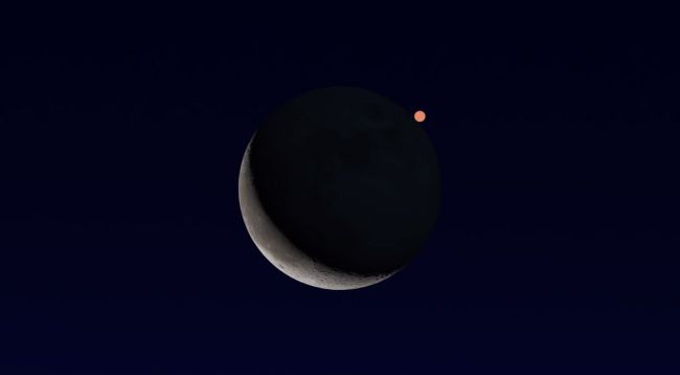
By | Space.com
As the waning crescent moon rises in the small hours of the morning of Tuesday, Feb. 18, skywatchers will be preparing for an unusual event. That morning the moon glides in front of orange, starlike planet Mars for viewers in much of central and eastern North America, in what is known as an occultation.
Parts of the western and central U.S. and Canada will be able to view both the disappearance and reappearance of the Red Planet in a dark or twilight sky. However, from western Canada, the Pacific Northwest and northern portions of California and Nevada, only the end of the occultation will be seen, since Mars will already be behind the moon when it rises around 3:30 a.m. local time. On the other hand, across the Eastern U.S., the planet will both disappear and emerge after sunup.
Under reasonably dark skies, this event can be watched over western locations with the naked eye or binoculars, although a telescope will provide the best views. Over the Desert Southwest and parts of the Rocky Mountain States along and east of the Continental Divide, the entire event will occur under a dark sky, but will take place very low in the east-southeast; an open view of the horizon is required. Right now, Mars is relatively faint at magnitude +1.2 and will be dimmed further by its low altitude, but it should not be hard to spot.
Near and immediately east (right) of a line extending roughly from Santa Barbara, California to Idaho Falls, Idaho to Havre, Montana, the bright limb of the moon occults the planet when it is still too low to view. But Mars' reappearance from behind the moon's dark limb will be much more observable because the moon will be higher above the horizon and the planet won't be washed out by the crescent's bright glare.
Unlike the pinpoint image of a star, which upon interaction with the moon appears to vanish or reappear as if you've clicked a switch, the larger apparent size of Mars causes it to disappear or emerge more gradually. About 15 seconds should elapse for the moon to fully cover (or uncover) the tiny disk of Mars after the edges of the two bodies appear to make contact. But the duration will be slightly longer for locations well to the north or south, where the occultation is not nearly central.
Mars currently shows a gibbous disk with an apparent diameter of 5.1 arc seconds. The first speck of light from the Red Planet when it reappears from behind the moon will be at the moon's dark limb and can be spotted by an observer looking in the right place with a small telescope. Mars will emerge into view as a tiny, brilliant fiery blob — seemingly like a burst of lava from some great lunar volcano.
In order to help observers anticipate where Mars will disappear (behind the moon's bright limb) and reappear (from behind the moon's dark limb), the accompanying diagram shows the apparent path of Mars as seen from various cities. The numbers specify the cities as given in this list. For some locations (such as San Francisco, #17), the disappearance will occur before moonrise, so its track on the left is not shown.
More difficult farther east
As one heads east, the occultation will take place after the break of dawn and the advance of morning twilight. Across the northern and central Great Plains, as well as the western half of Oklahoma and Texas, Mars will disappear in a dark sky, but twilight will be well advanced when it reappears. Binoculars or a telescope will be needed to see the emergence from behind the moon's dark limb. From the Great Lakes, Greater Ohio Valley and the Deep South, Mars will disappear in a twilight sky and reappear after sunrise.
















